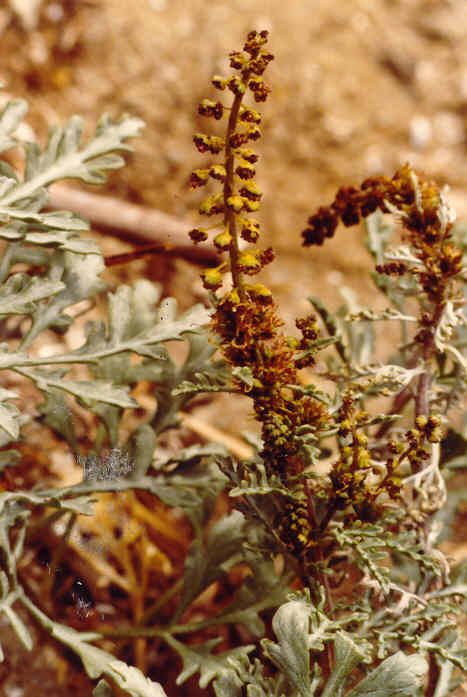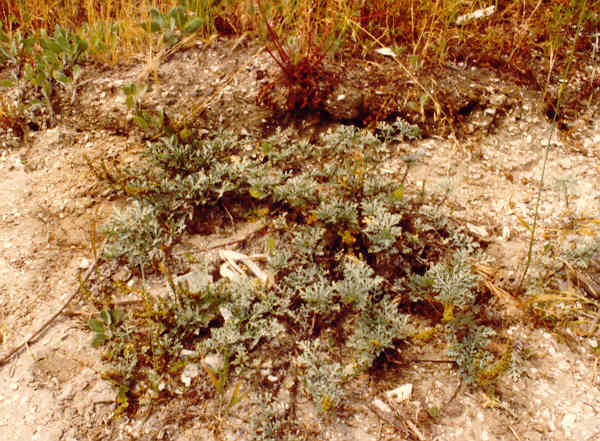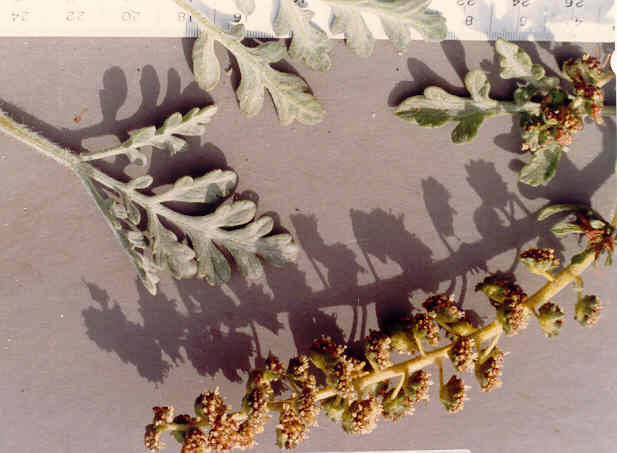
 |
Ambrosia chamissonis (Less.) E. Greene=Franseria bipinnatifidaAsteraceae (Sunflower Family)NativeBeach Bur |
April Photo
Plant Characteristics:
Perennial monoecious herb with radiating procumbent branching stems from
caudex or tap root, forming loose mats 1-3 m. across and 1.5-3 dm. high; herbage
silvery canescent with silky hairs, the stems more hirsute; lvs. simple, the
blades ovate, rhombic, or oval-oblanceolate, usually obtuse, crenate-serrate to
bluntly toothed or lobed or even incised, 2-5 cm. long, tapering to a petiole
nearly as long; staminate heads in congested terminal spikes, 7-8 mm. wide;
pistillate heads borne in lf.-axils below the male racemes, 1-fld., their invol.
+/- turbinate, at maturity armed with several rows of prickles below the 1-4
beaks, bur 7-10 mm. long, its spines flattened or channeled, not hooked.
Growing along with the form above described are plants with lvs. once to
thrice pinnatifid into oblong or obovate segms., less silvery; fr. glandular but
not hairy, the spines often more slender and less sulcate (longitudinally
grooved). These two forms are said
to hybridize freely, yet the two main types persist side by side.
This second form has been treated taxonomically in various ways: as a
var. in Franseria as bipinnatisecta
Less.; as a ssp. by Wiggins and Stockw., also under the name bipinnatifida,
as a sp. in Gaertneria by Kuntze, in Ambrosia
by Greene; as a var. dubia under F. bipinnatifida by Eastw.; and as a forma bipinnatisecta in Franseria by
Calder and Taylor. Payne gives no
taxonomic recognition. (Munz,
Flora So. Calif. 110).
Munz, Flora So. Calif. and Hickman, Ed. combine the various leaf forms
under A. chamissonis.
The local form has bipinnate leaves. (my comments).
Habitat:
Coastal Strand, n. to B.C.; San Clemente, Santa Catalina, San Miguel and
Santa Cruz Ids. July-Nov.
Name:
Ancient Greek, also Latin name of several plants meaning "food of
the gods". Its application to
these weedy species is obscure. The
species name honors Adelbert Von Chamisso
(1781-1838), the German poet, writer and naturalist who visited Calif. in 1816
with a Russian expedition that also included John Eschscholtz (1793-1831), for
whom Chamisso named the Calif. Poppy. (Dale
51). Latin, bipinnatisecta, refers to
the doubly pinnately divided leaves. (John
Johnson).
General:
Uncommon in the study area, the photographed
specimen was on North Star Beach. (my comment).
Ambrosia and Franseria species have been known to cause hay fever and asthma,
also dermatitis. (Fuller 143,371).
About 40 species, largely of warmer parts of America.
(Munz, Flora So. Calif. 109).
Leaf forms intergrade; pls. with compound lvs. have been called A.
bipinnatifida. (Hickman, Ed.
193).
Text Ref:
Abrams, Vol. IV 150; Hickman, Ed. 193; Munz, Calif.
Flora 1105; Munz, Flora So. Calif.
110.
Photo Ref:
April 7 83 # 11,12; Feb 2 84 # 6.
Identity: by R. De Ruff, confirmed by F. Roberts.
First Found: February 1984.
Computer Ref: Plant Data 143.
Have plant specimen.
Last edit 7/14/05.
 |
 |
April Photo February Photo